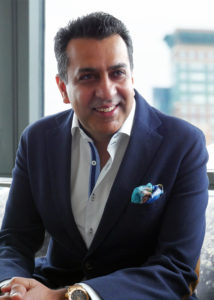With a laser-sharp focus on customer centricity, focus on ‘learning quotient’ in employees, and investing in newer technologies for growth, Mphasis is pulling all stops to be suitably placed to cater to its every customer need and grow into a US $10 billion company in the next 3-5 years
 Five years ago, when Mphasis took the decision to become a cloud-first, cognitive-first company by embracing new technologies for digital transformation, little did it know the impact that such a move would have on its business during the pandemic. While the vision behind this decision was to build a future-ready business with a higher focus on customer centricity, the resulting pivot and foresight helped the company tide over it and unearth new ways to engage and make significant gains. “Newer, emerging technologies were changing the way businesses operate and we wanted to help our clients reflect the same. We invested in nex-gen technologies with our customer-centric Front2Back digital transformation methodology. This, along with taking measures to stay close to our clients and adapting to their shifting needs helped us overcome these challenging times and even grow 30% y-o-y across all sectors in FY22,” says Nitin Rakesh, the managing director of Mphasis.
Five years ago, when Mphasis took the decision to become a cloud-first, cognitive-first company by embracing new technologies for digital transformation, little did it know the impact that such a move would have on its business during the pandemic. While the vision behind this decision was to build a future-ready business with a higher focus on customer centricity, the resulting pivot and foresight helped the company tide over it and unearth new ways to engage and make significant gains. “Newer, emerging technologies were changing the way businesses operate and we wanted to help our clients reflect the same. We invested in nex-gen technologies with our customer-centric Front2Back digital transformation methodology. This, along with taking measures to stay close to our clients and adapting to their shifting needs helped us overcome these challenging times and even grow 30% y-o-y across all sectors in FY22,” says Nitin Rakesh, the managing director of Mphasis.
Today, its leaders talk of continuing to grow above industry average and working towards becoming a US $10 billion company in the next three to five years. Their goal is also to expand its addressable markets on the back of geographic expansion and capabilities build-up. For example, for Mphasis, the UK is the next big market for banking outside of the US. With access to a vast talent pool, proximity to clients, improved security, increased scalability and ease in delivering digital transformation for clients, the company has been able to increase its share of revenues from clients in the UK and Europe to 13% (from 10% three years ago). Likewise, Mphasis has also expanded its presence to other geographies like Costa Rica, Estonia, Taiwan, Mexico and Germany. Nitin adds here that “We will also be looking at strategic mergers and acquisitions which can bolster our revenue by 4 to 5%.”
Further in this interview with the Smart CEO, Nitin goes deeper into sharing with us the various ways Mphasis has developed a keen eye on customer centricity, and what the future of digital transformation looks like.
Tell us more about the kind of digital transformation technologies Mphasis has adopted, and implemented in its own, and in client businesses.
We focused heavily on strategy and execution, leveraging domain expertise alongside the latest technologies to drive client outcomes and digital transformation initiatives. Aside from this, a few years ago, we started on our digital transformation journey by creating a blueprint to migrate our entire workload to the cloud. The project ran for three years and was completed just before the onset of the pandemic in early 2020. Today, we are at par with any of the cloud-born companies in how we consume the latest technologies and services. This complex digital transformation exercise was yet another part of our vision to become a ‘customer first’ organization. The biggest tangible benefit that we achieved through this transformation was time to market, thereby providing the ability to recognize revenue much ahead of what it was earlier.
Given that newer technologies are constantly emerging in these markets, what steps are you taking to upskill your employees to help them stay relevant?
We are entering an era where employees must learn and adapt throughout their career. However, if we expect employees to be able to do this, we should have our leaders lead by example. So, we put some practices in place;
- We created a positive atmosphere for employees where they are constantly inspired to utilize their full potential by integrating learnability and agility
- We internalized the belief that “it is cool to be a geek”. The Geek Quotient initiative is a movement beyond ranks, knowledge, expertise and even technology, where an employee can enhance their lifelong learning to stay relevant in the company, and for their own personal benefit
- We introduced TalentNext, a cognitive automation tool, to foster a learning culture and create a solution-centric mindset for employees. In this, the ‘learning recommendation engine suggests over 750 skills that they can learn across 12,000 courses. These courses enable them to compete effectively in the constantly evolving demand and supply market
During the year 2020-21, nearly 12,435 employees completed one or more of their training courses on Talent Next.
Tell us a little bit about your approach to hiring people.
We’re currently living in a world where range is important, because we’re asking employees to do a lot more than just one task in their role. We’re asking them to not only develop IQ and EQ, but also what I call LQ, or “learnability quotient.” That’s a measure of how well and how quickly they can learn new skills in order to stay relevant. At least in the tech industry, there is high demand for employees to constantly upgrade themselves because things change very rapidly.
Keeping all this in mind, at Mphasis, we have adopted a collaborative hiring approach with deeper involvement by business in the entire hiring cycle. Business stakeholders invest themselves in hiring efforts and in many cases co-owning talent acquisition goals.
Where do you see Mphasis 3-5 years from now?
Customers demand agility and customer centricity. We have gone deep into design architecture and engineering to not wait for them to define the problem but to engage with them early and help them define and solve the problem. This has become the magic formula for us.
I believe that the overall growth environment is really robust for the next three to four years, and beyond the traditional tech spends, there are emerging trends that are pushing the addressable market higher for services companies. I foresee the industry’s future growth being driven by three factors;
- Growth of tech services market
- Shift toward a subscription model of consumption
- Tech spends originating from new areas
I believe that as clients move away from on-premise cloud architecture towards a consumption in a service model, the capex will reduce, thus leading to increased spend availability. This could drive growth if we are able to construct deals where we can enable the client to move in the direction of run versus change.
Another area that is beginning to gain scale and critical mass is that every part of the client organization across the value chain is getting digitized and tech-enabled. We are actually starting to see (in the last two to three quarters) what we are calling a tech investment super cycle. So, I would say it’s an interesting environment with a strong tailwind, a growth mindset and good investment appetite. Our goal in this is to be positioned in the right set of services so that they buy from us.
ITeS100 Mphasis
